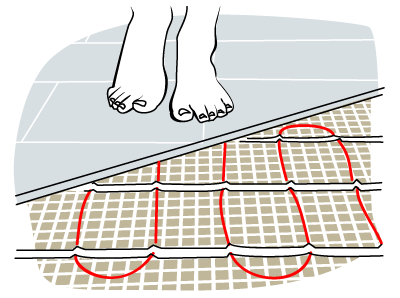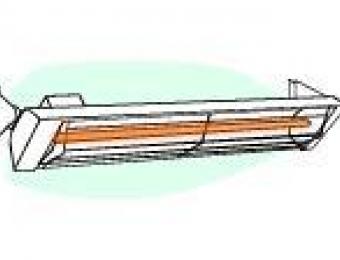
Underfloor heating systems are popular for people who live in colder climates - particularly in bathrooms and living areas. They heat the home and remove the shock of warm toes on cold floors in the morning. While hydronic underfloor heating is a popular choice for many homeowners, electric systems have their own merits as well.
Types of electric underfloor heating
There are three common types of electric underfloor heating systems used in homes. All involve laying heating wires under the floor, and can usually be controlled by a thermostat. Some of these heaters can be connected to off peak or smart meters to take advantage of reduced electricity rates during off peak hours.
In-slab heating - In this system, the wires are laid within the concrete slab itself, then the floor finish is laid on top (tiles, wood, stone and so on). The heat generated from the wires heats up the concrete slab, which then gradually transfers the heat to the surface of the floor, and radiates it into the room.
In-screed heating
Under-tile heating/carpet floor heaters - For these systems, the wires used are generally extremely thin. They are placed on top of both the concrete slab and the screed, directly under the tiles. The heat generated from the wires transfers directly into the tiles and up into the room, making this one of the quickest heating systems. Under tile heating's quite popular in bathrooms, where they can take the chill off and make the tiles nice and cosy to walk on.
Carpet floor heaters work in a similar manner, except with carpet on top instead of tiles. Many of these systems are available as do-it-yourself kits.
How do they work?
Electric underfloor heating is best described as a radiant heating system. The heat radiates from the wires into the floor, which then releases the heat into the room and warms it up. In contrast to a localised heat source like a column heater which is designed to heat one area of the room, underfloor heating spreads and emits warmth over the entire floor area. This keeps the room at a relatively constant temperature.
As the system works via heat transfer from one material to the other, this type of heating system is most ideal for floors that don't contract or expand too much with temperature changes (tiles, wood, stone). They are also suitable for use with floors that are made out of good heat conductors to minimise heat loss during the energy transfer.
Some electric underfloor heating systems are designed specifically for use with certain types of floor materials - make sure the system you're choosing suits your floor before you buy it.
Under-floor heating and wooden floorboards
One thing to consider if you've got wooden floorboards (or timber laminate, or anything similar) is the possibility of 'cupping' due to the heat from the underfloor heaters. Changes in the moisture content of the timber can cause it to 'cup' or bend up at the edges, which is obviously a bit heartbreaking. It's entirely possible for timber floors and underfloor heating to coexist peacefully, but it's important that it's done carefully.
This usually means using an embedded temperature probe (or something similar) to ensure that the heating never exceeds a temperature that's likely to significantly affect the moisture content in the timber. Different types of timber will react differently to heat too - if you're interested in taking this route, make sure you talk to an expert, and that whatever you're buying you have a clear, written warranty.
Efficiency
Since hot air naturally rises, floor heating systems don't require energy to project heat to where it's needed like other systems might.
In-slab heating, while one of the cheapest options of underfloor heating to install, is also one of the most inefficient types of heating available. The heat is generated by the wires and stored in the slab, which then releases the warmth into the room at night. However, the slab may need to be heated continuously for a long time (maybe even a few days) to prime it before it has enough heat stored up to be effective. It will also usually need a 'boost' in the evenings, while electricity tarrifs are still high.
Under-tile heating acts more quickly as it is located directly below the floor surface instead of being embedded within the concrete or screed, and for this reason only needs to be on when heating is required. It can be zoned so that only the areas that you want heated are turned on, and the speed at which the heat transfers means you don't have to wait too long for the room to get warm. As a result under-tile and carpet heating is far more efficient than slab and screed based electric floor heaters. While these types of heaters are less efficient than reverse cycle heat pump heaters, they do stack up favourably against some other types of electric heaters.
How much do they cost?
Electric underfloor heating systems use fewer components and are simpler to install than hydronic heating systems. Some under-carpet and under-tile systems even come as do-it-yourself kits, which helps minimise the installation costs. Running costs vary greatly between different types of systems. In-slab floor heaters are very expensive to operate, while under-carpet and under-tile systems can be operated quite cheaply, thanks to the fact that they can be thermostatically controlled, zoned and switched on and off as required.
|
Advantages
|
Disadvantages
|





